Other Designs
Barrels Design
Clover Leaf
Ellipsoidal Design
Ellipsoidal Modules
On Three Levels
Pentagonal Ring
Hexagonal Ring
6-segment Anulus
Torus Dwelling
Twin Daisy Dwelling
Yin-Yang Design
Multi-Petal Designs
Other Designs
These renderings of the universal terrestrial dwelling are an attempt to inject some character into the shapes of the component activity-space envelopes. Here I experiment with fluted ellipsoids, hexagonoids and tori linked together in various configurations.
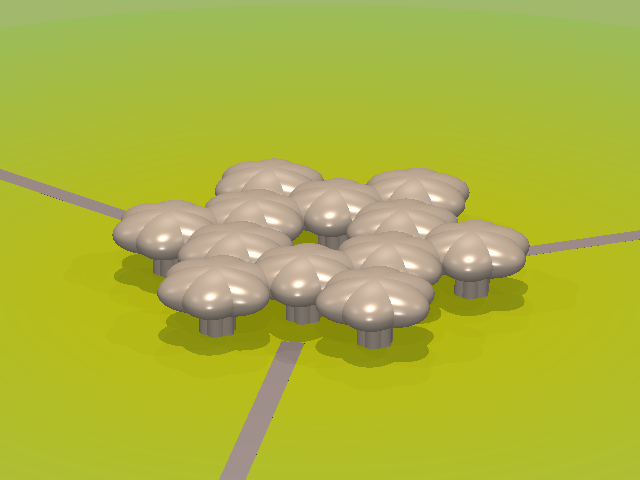 This design is a variant of the snowflake configuration of ellipsoidal shells described in the previous article. The difference is in the form of the shells themselves. These shells are formed by rotating and merging 3 general (sausage shaped) ellipsoids to produce the fluted effect shown on the right. This gives more character and structural strength to each shell. It produces quite a pleasing appearance, both from the inside and the outside.
This design is a variant of the snowflake configuration of ellipsoidal shells described in the previous article. The difference is in the form of the shells themselves. These shells are formed by rotating and merging 3 general (sausage shaped) ellipsoids to produce the fluted effect shown on the right. This gives more character and structural strength to each shell. It produces quite a pleasing appearance, both from the inside and the outside.
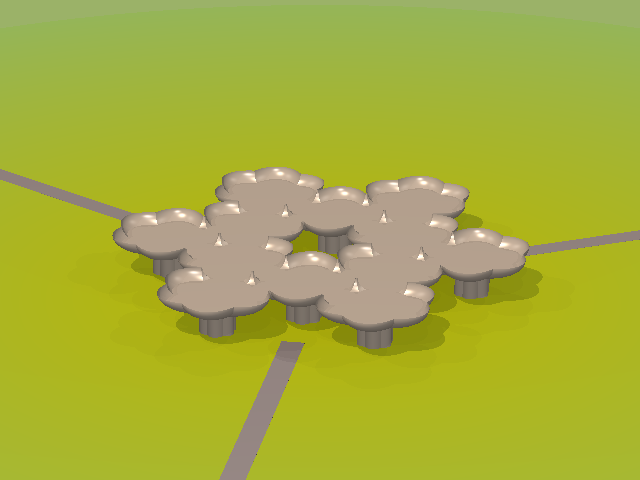 Connection between adjacent shells is accomplished by moving the shells inwards radially so that they partially merge, as described in the previous article for the pure ellipsoid shells. The shells are oriented so that their flutes are in line with each other. This maximises the aperture of the access between adjacent shells, providing a higher and wider doorway for a given radial contraction of the overall dwelling.
Connection between adjacent shells is accomplished by moving the shells inwards radially so that they partially merge, as described in the previous article for the pure ellipsoid shells. The shells are oriented so that their flutes are in line with each other. This maximises the aperture of the access between adjacent shells, providing a higher and wider doorway for a given radial contraction of the overall dwelling.
 Above is a view of the dwelling sliced off at the zero horizontal plane, thus revealing the pleasing form of the floor areas. On the right is a view of the dwelling complete with skylight windows and patio roof cut-outs. The shells are coloured to show the groupings of activity spaces into the three classes of work, rest and play. The dwelling's support pillars are fluted also to match the flutes of the shells. This version of the dwelling was generated by fluted.pov
Above is a view of the dwelling sliced off at the zero horizontal plane, thus revealing the pleasing form of the floor areas. On the right is a view of the dwelling complete with skylight windows and patio roof cut-outs. The shells are coloured to show the groupings of activity spaces into the three classes of work, rest and play. The dwelling's support pillars are fluted also to match the flutes of the shells. This version of the dwelling was generated by fluted.pov
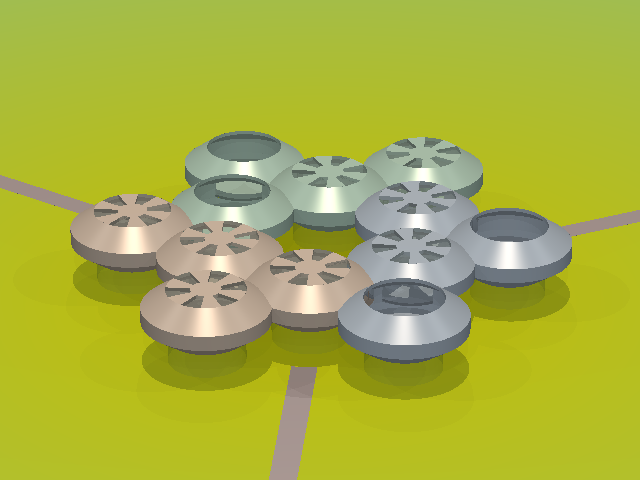 Mathematical shapes like the ellipsoid and its variants are difficult to fashion with conventional tools and materials. For this reason, I tried two variants with the cylinder as their basic shape. The first, shown on the left, has shells in the form of squat cylinders which are chamfered top and bottom to form an open cylindrical belt, capped top and bottom by truncated cones. This version was generated by POVray using cones.pov.
Mathematical shapes like the ellipsoid and its variants are difficult to fashion with conventional tools and materials. For this reason, I tried two variants with the cylinder as their basic shape. The first, shown on the left, has shells in the form of squat cylinders which are chamfered top and bottom to form an open cylindrical belt, capped top and bottom by truncated cones. This version was generated by POVray using cones.pov.
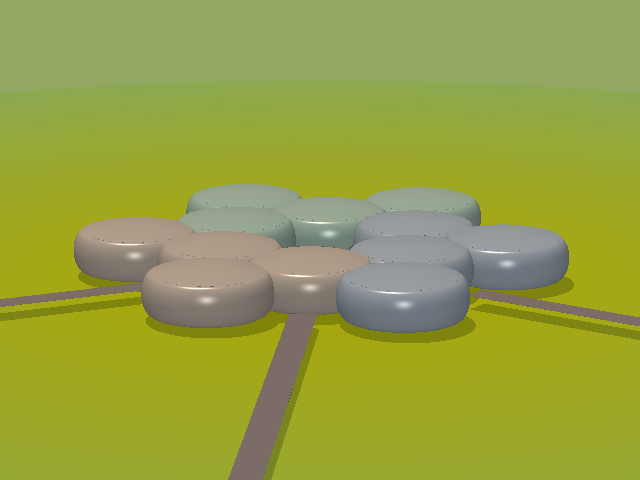 The second cylinder-based version, shown on the right, appears like bulging cylinders. However, each shell is, in fact, made up of a sphere which is truncated top and bottom and capped top and bottom with spherical caps of a much greater radius. The result is that the dwelling appears to be made up of merged inflated cylinders. Hence the name of the POVray program inflatable.pov, which was used to generate it.
The second cylinder-based version, shown on the right, appears like bulging cylinders. However, each shell is, in fact, made up of a sphere which is truncated top and bottom and capped top and bottom with spherical caps of a much greater radius. The result is that the dwelling appears to be made up of merged inflated cylinders. Hence the name of the POVray program inflatable.pov, which was used to generate it.
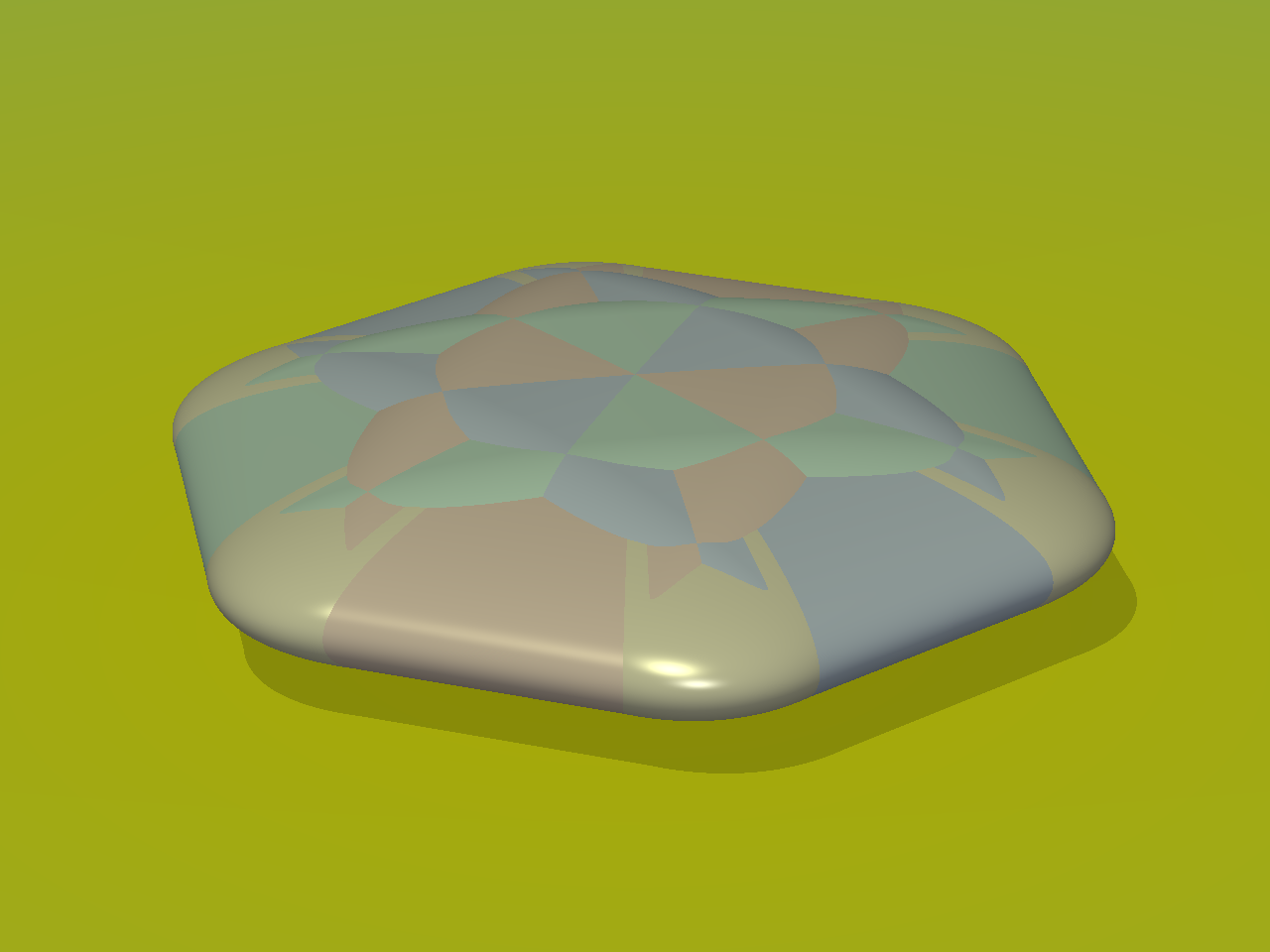 This is a complete departure from the pure ellipsoidal envelope format. This hexagonoid form is based on an open cylinder of elliptical cross-section, which is capped at both ends by a general ellipsoid sliced in half, whose major elliptical cross-section corresponds to that of the cylinder. This shape is then {rotated by 60°, re-coloured and merged} twice to produce the finished activity-space envelope shown on the left.
This is a complete departure from the pure ellipsoidal envelope format. This hexagonoid form is based on an open cylinder of elliptical cross-section, which is capped at both ends by a general ellipsoid sliced in half, whose major elliptical cross-section corresponds to that of the cylinder. This shape is then {rotated by 60°, re-coloured and merged} twice to produce the finished activity-space envelope shown on the left.
 Six of these envelopes (or shells) are then arranged as shown on the right to form the complete dwelling. The shells are oriented so that the points of the hexagons merge, thus creating an access aperture between adjacent shells. This arrangement results in an attractive star-shaped internal garden being created in the middle of the dwelling. This version of the dwelling was generated by POVray using hex.pov
Six of these envelopes (or shells) are then arranged as shown on the right to form the complete dwelling. The shells are oriented so that the points of the hexagons merge, thus creating an access aperture between adjacent shells. This arrangement results in an attractive star-shaped internal garden being created in the middle of the dwelling. This version of the dwelling was generated by POVray using hex.pov
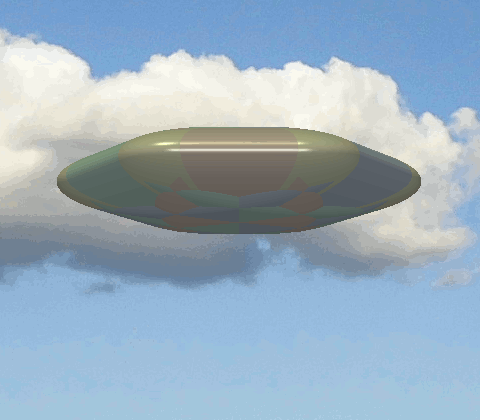 The hexagonoid shell is straight-edged, yet all its surfaces are rounded. This renders it very resistant to high winds and violent weather. Its streamlined profile also enables a shell to become vehicular. To move to a new location, the dwelling can disintegrate into separate shells. These can then travel independently, under their own power and guidance, to the other location, where they re-connect to form the integrated dwelling once again. The flying hexagonoid on the left is a conception of how the dwelling could relocate.
The hexagonoid shell is straight-edged, yet all its surfaces are rounded. This renders it very resistant to high winds and violent weather. Its streamlined profile also enables a shell to become vehicular. To move to a new location, the dwelling can disintegrate into separate shells. These can then travel independently, under their own power and guidance, to the other location, where they re-connect to form the integrated dwelling once again. The flying hexagonoid on the left is a conception of how the dwelling could relocate.
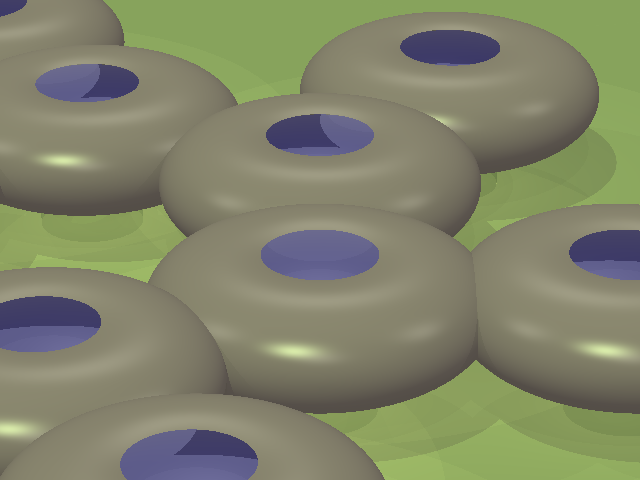 Within an activity-space enveloped by an ellipsoid, the ceiling is too high in the middle and too low around the periphery. To tackle this problem, I replaced the ellipsoid with a torus. I used a closed torus: that is, the major and minor radii were the same. I cut a central cylinder from the torus so that the floor (1 metre below the horizontal central plane) would not be interrupted by the inner curved surface of the torus.
Within an activity-space enveloped by an ellipsoid, the ceiling is too high in the middle and too low around the periphery. To tackle this problem, I replaced the ellipsoid with a torus. I used a closed torus: that is, the major and minor radii were the same. I cut a central cylinder from the torus so that the floor (1 metre below the horizontal central plane) would not be interrupted by the inner curved surface of the torus.
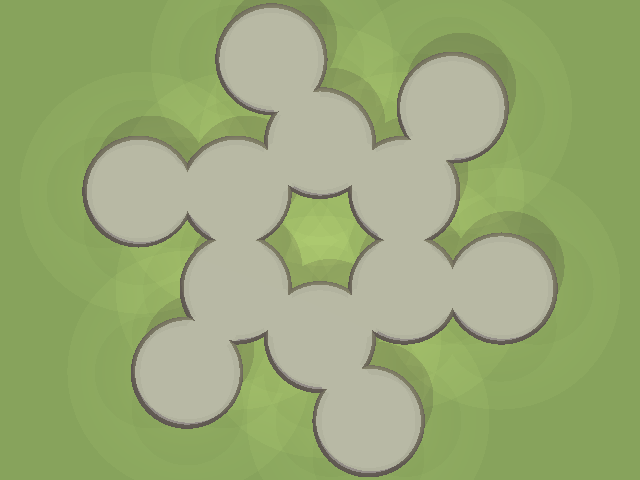 I placed a transparent spherical cap at the top centre and an opaque bottom cap to seal the envelope. The result is shown above on the right. These torus-based shells were then merged, as with the original ellipsoidal shells, using the galaxy configuration shown on the left and below on the right. On the left, the dwelling is shown sliced off along the horizontal zero plane, which cuts all the torus-based shells exactly in half horizontally.
I placed a transparent spherical cap at the top centre and an opaque bottom cap to seal the envelope. The result is shown above on the right. These torus-based shells were then merged, as with the original ellipsoidal shells, using the galaxy configuration shown on the left and below on the right. On the left, the dwelling is shown sliced off along the horizontal zero plane, which cuts all the torus-based shells exactly in half horizontally.
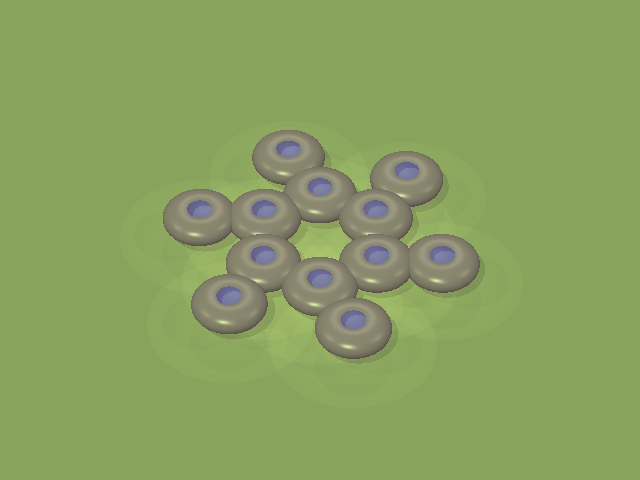 Thus was created a new form of the galaxy version of the merged ellipsoids dwelling but with each activity-space having a more even and consistent ceiling height. Like with the ellipsoid based version of the dwelling, the torus-based version also needs to be supported on pillars to raise its internal floor to 3 metres above the ground to leave adequate headroom for people to walk freely beneath the dwelling.
Thus was created a new form of the galaxy version of the merged ellipsoids dwelling but with each activity-space having a more even and consistent ceiling height. Like with the ellipsoid based version of the dwelling, the torus-based version also needs to be supported on pillars to raise its internal floor to 3 metres above the ground to leave adequate headroom for people to walk freely beneath the dwelling.
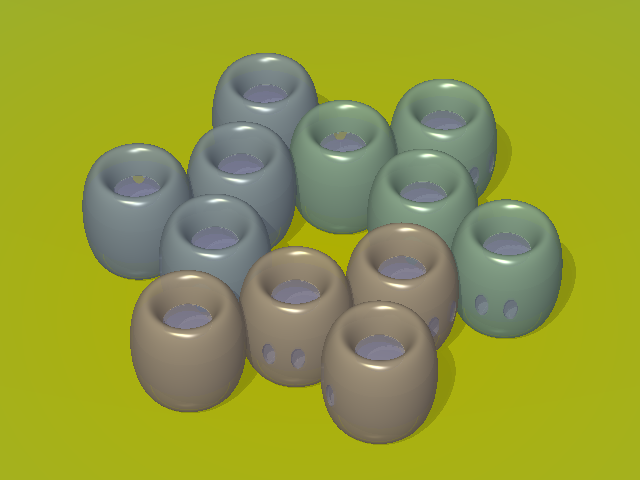 I never really liked the use of pillars. They emerged from the philosophy that the dwelling should impinge on the Earth as little as possible. However, I decided to attempt a compromise. I elongated the torus-based shells to the extent that, while maintaining their inner floors three metres above the ground, they each made a circle of contact with the ground. The result was the barrel-shaped activity space envelopes shown on the left.
I never really liked the use of pillars. They emerged from the philosophy that the dwelling should impinge on the Earth as little as possible. However, I decided to attempt a compromise. I elongated the torus-based shells to the extent that, while maintaining their inner floors three metres above the ground, they each made a circle of contact with the ground. The result was the barrel-shaped activity space envelopes shown on the left.
The torus barrel also elongates a corresponding amount upwards. This provides an inner roof space, which is useful for enclosing such things as water tanks and radio antennas.
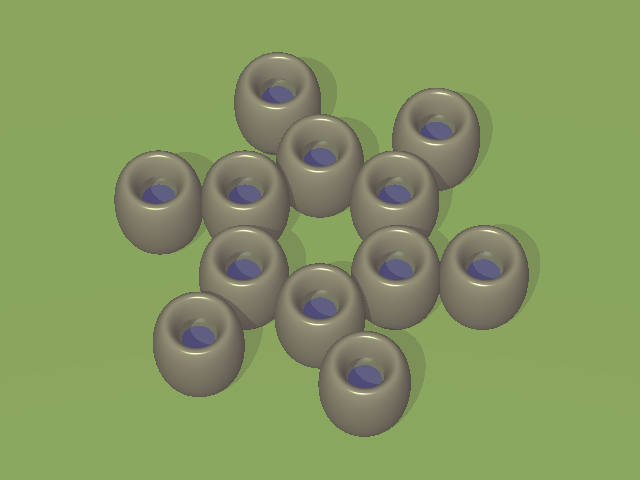 On the right, the barrels are shown in the galaxy configuration as opposed to the snowflake configuration above. The barrels version is aesthetically pleasing and offers easy access to ground level. However, it lends itself less well to vehicular activity. It is also mathematically difficult to merge tori in a seamless way to form interconnecting corridors. Perhaps I shall try this some time. All torus-based versions of the dwelling were generated by toroids.pov
On the right, the barrels are shown in the galaxy configuration as opposed to the snowflake configuration above. The barrels version is aesthetically pleasing and offers easy access to ground level. However, it lends itself less well to vehicular activity. It is also mathematically difficult to merge tori in a seamless way to form interconnecting corridors. Perhaps I shall try this some time. All torus-based versions of the dwelling were generated by toroids.pov
 The final variant of the torus which I tried is shown on the left. It comprises the outer section of one torus joined to the inner section of another torus with a different major to minor radius ratio. The result is a torus with a more abrupt inner wall separating the inner circle from the outer rim. This version is particularly useful for creating patios with indoor ante-room space. This version of the dwelling was generated by POVray using rings.pov
The final variant of the torus which I tried is shown on the left. It comprises the outer section of one torus joined to the inner section of another torus with a different major to minor radius ratio. The result is a torus with a more abrupt inner wall separating the inner circle from the outer rim. This version is particularly useful for creating patios with indoor ante-room space. This version of the dwelling was generated by POVray using rings.pov